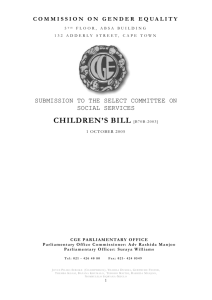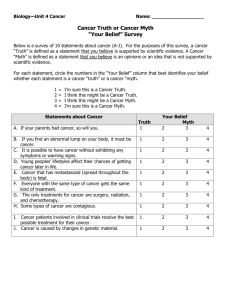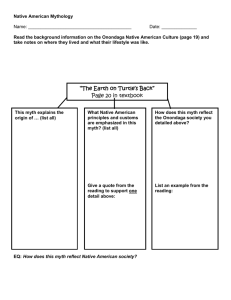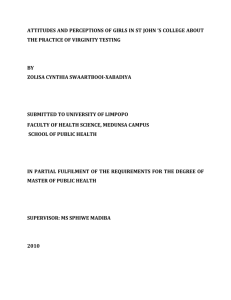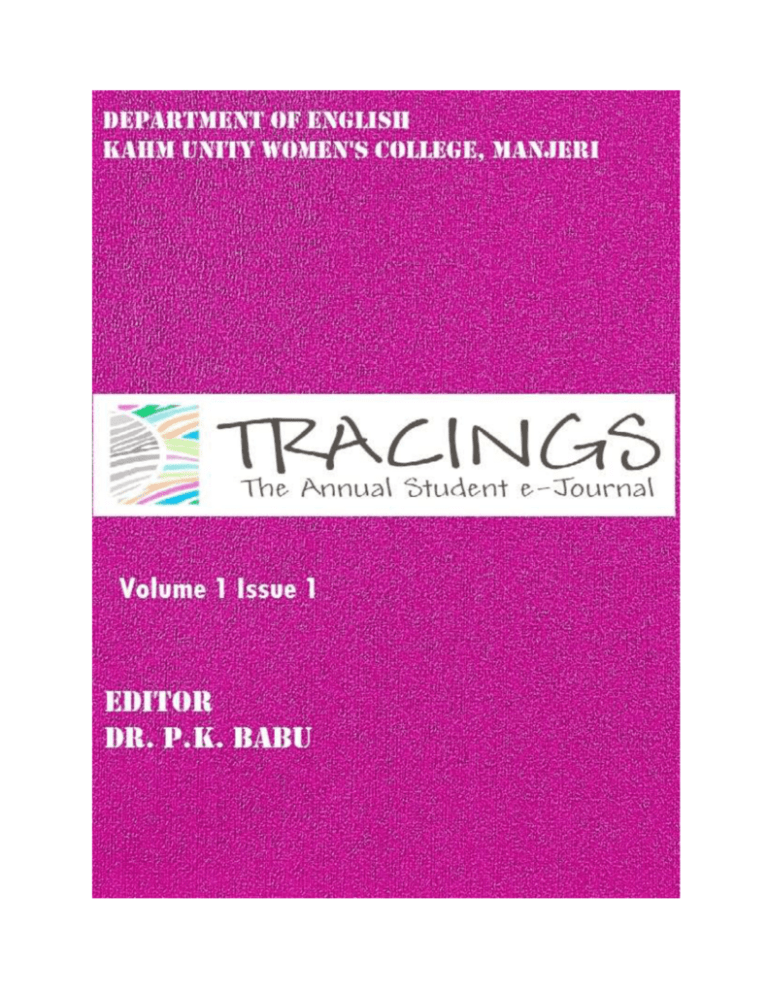
The Myth of Virginity
Changing Perceptions in Popular Culture
Nuzla Thabassum Kattukandathil
3rdsem M.A English
Farook College, Calicut
ABSTRACT
The female body, sexuality and identity are well discussed and defined in every society, cult and
civilization; be it ancient, medieval or modern. Unfortunately, these discussions and definitions
are intended more to confine the female species into the four walls of home rather than giving
them recognition in the public and political scenarios. In order to propagate their ideas the
patriarchal hegemony has created stories and myths regarding the female body and sexuality.
“The Myth of Virginity” is one of them. What is virginity? How can we define virginity? Why
is it ascribed only to women and not men? Is it an entity that can be measured? Or is it simply a
myth created to control the female folk? If so then why is it still significant in the post-feminist
era? These are some of the questions and issues that are dealt in this paper. This paper also
examines how the concept of virginity is presented in popular media like movies, TV shows and
works of fictions in relation to the particular societies in which they are presented, both in
favouras well as in opposition to it. Apart from that the paper also gives an insight to the origin,
propagation and even manipulation of this myth, citing examples from various civilizations,
cultures and mythologies. Eventually it is attempted to establish the malevolence behindthis
myth and how the notion is subverted in the present scenario.
Keywords: Virginity, myth, popular culture, hymen, feminism, patriarchy
The female body and sexuality have always been an entity that men tried to control,
either through direct force or through indirect manipulations. While beating, whipping and other
sorts of physical violence formed the direct method; indirect tools turned out to be even more
terrifying as it was something that was incorporated into the psyche of the male as well as the
female species. The Myth of Virginity is one such psychological and cultural manipulation that
has been inducted into the collective consciousness of mankind, so that even today, in the postmodern, post-feminist era losing the virginity of women outside the bond of marriage is
considered as the highest offense. And moreover the popular cultural tools of every cult and
civilization ensured that this myth is communicated and propagated with a lasting effect. In order
to ease the analyses of understanding of the myth of virginity and how popular culture have
enabled the dissemination of this theory into the society, it important that one should be familiar
with the two key terms- ‘Virginity’ and ‘Popular Culture.’
The term virginity has been used to describe women, rather men, who abstain from
sexual intercourse with men. It is also defined by some science texts as the breaking of a narrow
vaginal tissue membrane known as hymen. From this perspective things seem quite simple, but
they are not as it seems and this is where popular culture plays its part.
Popular culture as we know is the mainstream phenomenon of a given culture or society.
The distinctive feature of popular culture is that, rather than being the cultural culmination
accepted by a society, it often turns out to be a tool used to induce the political interests of the
ruling section of the society. From this perspective it can be clearly understood that the definition
of virginity is not scientific or biological, but purely cultural, that has been described by various
religious texts, mythologies and even historical records, where the women had no role or
participation of any kind. According to such media stories, it is divine for a woman to remain
untouched by any man before marriage and the one who breaks it is punished severely.
The ambiguity of these definitions lies in the fact that it is a product of male hegemony
rather than female experience. Hence it is biased and often broken by the creators of this very
rule itself. Such an occasion can be cited in the eastern mythologies. In the epic of Ramayana,
the warrior Lord Rama kills the demon King Ravana and saves his wife Sita from the captivity of
Ravana. This epic is known to every Indian but the story every girl of India must know is that
despite being in the custody of Ravana, Sita was still a woman of chastity and that her purity was
so sure that she did not burn in the fire test thrust upon her by her beloved. This story is
considered as the epitome of morality for women in the eastern sub-continent especially in India.
Interestingly we also have another beautiful mythology rising from the same land, the myth of
the birth of Veda Vyasa, the author of the great epic of Mahabharata. Satyavadi, the mother of
Vyasa was the daughter of a fisherman. One day while she was taking a sage called Parasaran to
the other side of the river on the boat alone; he was attracted by her great beauty and expressed
his desire to have her for once. Since he was a Brahmin sage she did not yield at once but then
she agreed to his advances after he granted her three wishes; 1) her fishlike sting should be
changed into the fragrance of Kasthuri. 2) No one should witness their union and that she should
remain virgin even after their union. 3) The responsibility of upbringing the child should be
entirely upon the sage. And they consummate, thus Veda Vyasa is born. The story is indeed quite
entertaining but the second wish granted to her poses certain valid questions. If virginity is
something that can be restored then why is there so much chaos regarding losing it? And why is
that only she chooses to have her virginity and not the sage? And moreover what is the real
definition of virginity then? From the above incident we can clearly observe that virginity is
nothing but a myth. A pure piece of cultural dominion imposed upon the female species in order
to prevent them from having a sexual identity of their own.
Even today constraints of virginity pull down the girls from empowering themselves or
challenging the society as the character of a girl is determined simply by her sexual purity. The
popular media also propagate similar ideas. For instance, in the early movies (up to late 90’s),
the antagonist often takes revenge upon the protagonist by raping the women in their families.
These women are then seen committing suicides as they feel that they have lost their ‘izzat’ or
reputation. Though virginity as an entity has nothing to do with ‘honour’ it is often used as a
synonym for virginity. This is also very systematically assimilated cultural manipulation by the
patriarchal society where the female virginity is combined by the family reputation; and losing of
it means disgracing the family honour. The interesting point about this incorporation is that
nowhere here one sees a man losing virginity or has the fear of losing it. In fact it is considered
highly respectable and very often normal for a man to indulge in sexual activities with a woman
out of the bond of marriage.
This phenomenon of virginity is not just confined to the realm of eastern myth and
culture but also within the western tradition, from early Hebrew times, the woman’s sexual
purity was essential. “Thou shalt not commit adultery” proclaimed God in His seventh
commandment to the Israelites. Although intended for everyone, this commandment has been
usually applied primarily to the women. Patriarchs and kings had many wives, but the unfaithful
wife or the sexually active maiden was anathema. The prostitute or adulteress could be stoned to
death for her behaviour. For reference, one can flip open a Bible to the Book of Deuteronomy,
which declares that if "tokens of virginity be not found for the damsel … [then] the men of her
city shall stone her with stones that she die." This fearful judgment against women guilty of
sexual transgressions has continued even to the medieval times, where “fall” for women meant
sexual ‘mis’behaviour,i.e, the loss of virginity outside of marriage. The medieval veneration of
Virgin Mary brought this celebration of chastity to a climax. The elevation of Mary in medieval
iconography and thought resulted in the subsequent elevation of European women. Though these
are the prominent examples taken to define the role of chastity in a woman’s life there are
various other incidences that ask women to protect her chastity.
With the emergence of feminist movements in the late 19th century and the havoc created
by the Contagious Disease campaign, there began a new era of defining female body and
sexuality. Many feminists used literature as a reaction against the male sexual force and started
writing about their own experiences. This brought a great change in the modern western society
in their approach towards female virginity. It is no more considered divine. In the western
countries now-a- days it is normal for a woman to have pre-marital sex. The popular media now
also advocates this notion. But for every coin there is another face as well. Though women are
given the right to choose their sexual identity of being a virgin or not: it is more like choosing a
red apple from a basket of red apples. For instance an excerpt from Sidney Sheldon’s The Other
Side of Midnight proves the limitations in choice involved: “My God, she thought, going to die a
virgin. The only nineteen-year-old here at Northwestern. Northwestern, hell may the United
States! The Virgin Catherine. The church will make me a saint and they’ll light candles for me
once a year…” (Sheldon 17),
Again the idea is reiterated in the following lines:
… “Leave her alone” the brunette said.
“Why should I?” Jean Anne asked. “Who the hell does she think she is?” She turned to
Catherine. “Do you want to know want to know what everyone says about you?”
God no, “yes.”
“You’re a lesbo.”
Catherine stared at her, unbelievingly. “I’m a what?”
“A lesbian, baby. You’re not fooling anybody with that holier-than-thou act”. (Sheldon 20)
It can be clearly understood from the above example, the pressure that girls have to go
through in the society they are living in. Sexual liberation does not necessarily mean that one has
to ‘go wild’ but an option to choose for oneself the time, person and relation in which they can
have a relationship and the extent of it. Unfortunately this is misunderstood by our patriarchal
society and female liberalists.
Also this does not mean that the western societies no more believe in virginity. With the
emergence of science and technology many myths and superstitions were literally shattered but
in case of virginity: it was reinforced with much power especially with the discovery of hymen.
Hymen is a thin membrane in the vaginal opening which usually, though not necessarily, breaks
during an intercourse. This breaking of hymen is considered as a purity test by many modern
men. But this membrane may break due to stretching of the vaginal opening in varied
circumstances like riding a horse or a bicycle (reason why most girl children are advised not to
indulge in such sports especially in the Arab world). In the movie Wadjda, for example, the
mother advises her 10-year old daughter not to ride a bicycle as it may rupture her hymen and
consequently malign her virginity. In some rare cases there is just a stretching of the membrane
after sexual union and no snapping, thus regaining its shape after the procedure. However
patriarchal society is not concerned with these aspects at all.
Jessica Valenti in her book The Purity Myth describes how young girls in America try to
retain their hymen after sexual intercourse. Most girls even go to the extent of opting for surgical
methods to re-install the membrane often affecting their health adversely. Despite being a
modern society even America is obsessed with virginity and Jessica Valenti protests against this
attitude in her book; “There is a moral panic in America over young women’s sexuality—and it’s
entirely misplaced. Girls “going wild” aren’t damaging a generation of women, the myth of
sexual purity is” (Valenti 9).
This myth of hymen is shattered down by Laci Green, a 24-year-old YouTube sex
educator, when she released her YouTube video titled “You Can't POP Your Cherry (Hymen
101).”Through this video she explains that the hymen is not a membrane that needs to bleed or
be broken during intercourse and it is actually just small, usually elastic folds of mucous tissue
that only partially cover the vaginal opening and can, but not always, tear if stretched. A year and
a half after it premiered, with more than one million views, Green's video demystified one of the
most enduring misconceptions about virginity.
So this leads us back to where we started: What is virginity? How can we determine the
virginity of women? Why is this test of chastity only ascribed to women and not men? Again
such tests exclude the homosexuals and those who resort to alternative methods for penilevaginal penetration, questioning the very notion of virginity.
William Faulkner in his book The Sound and the Fury says:
“He said it was men who invented virginity not women. Father said it’s like death: only a
state in which others are left . . .” (Faulkner 68)
Despite its long history, virginity has never had a precise definition. More or less there is
nothing of such sort to even define as it is an abstract idea developed from the male supremacy
to control their opposite sex. Hanne Blank, in her book Virgin: The Untouched History, says that
it is quite difficult to pinpoint the exact origin of virginity as people have been talking about it
for as long as we have had written records and the earliest mentions of virginity suggest that it is
an established concept. One popular explanation, called the K-Strategist theory suggests that men
used virginity to help determine paternity- a way to make sure that the material resources they
devoted to new or expectant mothers were not a wasteful investment. Their obsession goes to
such an extent that in some places we see the “virginity locks” being made to restrain females
from having sex with men other than their husbands. In some cults the newlyweds are asked to
consummate their marriage on the very same night and display the blooded sheets before the
people as a test of virginity. The renowned Malayalam movie Chemmeen (film version of the
classic novel by Thakazhi Sivashankara Pillai), for instance, deals with one such popular legend
among the fishermen community along the coastal Kerala State in Southern India that if the
married fisherwoman shows infidelity when her husband was away at the sea, the Sea Goddess
(Kadalamma, literally means Mother Sea) would consume him. The fisher folk believe that a
fisherwoman should remain within the strict boundaries of tradition and an affair with other men
especially men belonging to other religion or community would subject the entire community to
the wrath of the sea.
The practice then evolved and spread to different communities, thus purity became
virginity for young girls and commodity for father to handover undamaged to their respective
suitors. The above instances make it clear that virginity is only one of the tools used to assert
power over women and nothing else. Apart from that, the theory of virginity secludes
homosexuals and also other forms of sex, since it is difficult to define these entities with the
established definitions and discourses.
The ultimate goal of every culture and civilization is to achieve the crown of “Ideal
State”. In order to achieve it they allocated roles for their subjects and rules to govern them.
Gender roles are the products of culture assigned to ensure that power remains in the in hands of
men and to reinforce these roles they created religion and myths. The myth virginity is, hence,
created to uphold these notions of society. Therefore battling against the myth of virginity and its
consequences is not simply reversing the damage done to young girls, but to establish a new
positive vision to view beyond the yards. A vision that teaches young girls in the society that
their ability to be good people depends on their being good people and not on whether or not
they’re sexually active or inactive.
References
Valenti, Jessica. The Purity Myth, How America’s Obsession with Virginity Is Hurting Young Women.
Seal press. 2009. Print.
Sheldon, Sydney. The Other Side of Midnight. Web.
The Atlantic. Living Myths about Virginity. Friday, 7 February 2014. www.theatlantic.com. Accessed on
Jun. 2015. Web.
Today.com. No Such Thing As Virginity, Author Says. Wednesday, 22 April 2009. www.today.com.
Accessed on Jun. 2015. Web.
Sydney Morning Herald. Let’s Talk About the Virginity Myth. Tuesday, 28 April 2015. www.smh.com.
Accessed on Jun. 2015. Web.
Faulkner, William. The Sound and the Fury. Web





